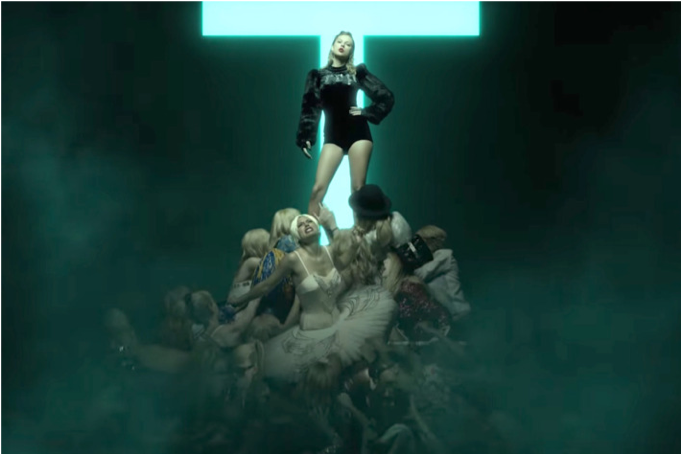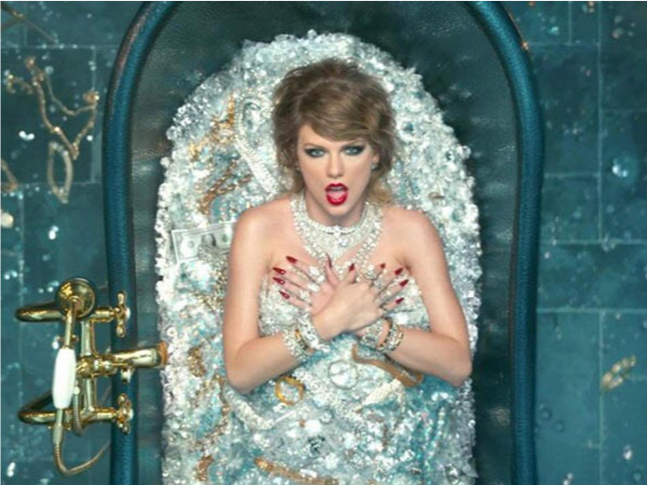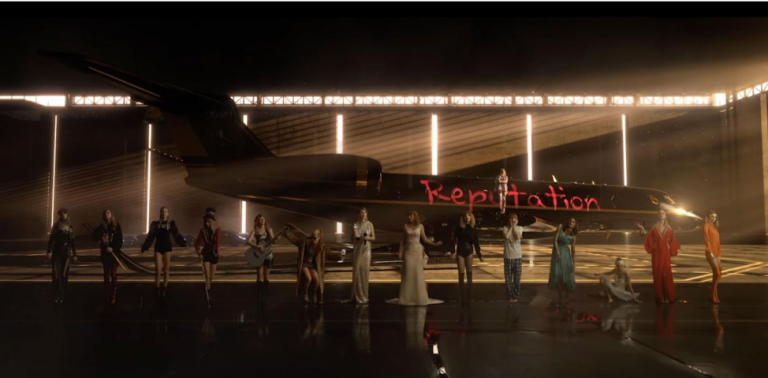When Divas Rise from the Dead: Taylor Swift, Uncanniness and Capitalism
Main Article Content
Abstract
Taylor Swift has died. Again. People who die tend to stay dead, but not Swift; the singer has fueled an outrageously successful eleven-year career with a cycle of symbolic deaths and rebirths. She arrived on the music scene in 2006 as an angelic teenage country singer with perfect curls, a closet full of virginal white dresses, and an album of love songs, and she most recently resurrected herself as a sexy, undead pop diva. In the music video for her 2017 single “Look What You Made Me Do,” she stages a massacre of her past selves, playing her own death(s) in costumes made famous by previous performances. Amid the carnage of the video, a “Zombie Taylor” character emerges, symbolizing the fundamental contradiction of Taylor Swift: the living-deadness of a brand masquerading as a person. Using the song and video as murder weapons against her former self, she provides a prism through which to view her career, public image, and role in American culture.

Taylor Swift appears as a zombie in her music video "Look What You Made Me Do" (Mashable)
Swift follows in a long tradition of murdered musicians. In her book Opera, or The Undoing of Women, philosopher Catherine Clément analyzes how opera exalts its women in order to kill them: men, who control the form, “punish” female characters for straying from their given roles of purity and submission, usually with death (4, 7, 10-11). “Crazy women” kill musicians too; in In Search of Opera, world-renowned musicologist Carolyn Abbate alludes to the Bacchantes of Greek mythology, who rip Orpheus limb from limb as he sings (1). The modern-day American public also likes to kill its stars, particularly female ones, for straying from defined roles. Taylor Swift’s original presentation of innocence and romanticism eventually attracted suspicion: how can she write such a devastated breakup song about someone she dated for “like, three weeks” (Dobbins)? And don’t those songs seem designed to embarrass her exes while promoting herself? The public likes to “reduce a woman to her image” and then destroy that image (Clément 28). As in another Orphic myth, in which Orpheus accidentally sends his beloved Eurydice to the underworld by looking at her, this gaze has a killing power. However, unlike Orpheus or the women of opera, Taylor Swift survives her death. In fact, she can only survive through death.
Swift killed herself before public scrutiny could, re-arising as a polished pop star in 2014 and as something darker in 2017. She boasts in “Look”: “I rose up from the dead, I do it all the time.” Certainly, other female stars have rebranded, but few as violently as Swift. Britney Spears, in her famous 2002 music video, kneels on a cliff to sing a piano ballad about an identity in transition: “I’m not a girl, not yet a woman.” By contrast, in “Look,” a Taylor wearing a leotard advertising her new album stands atop a pile of Taylors from previous music videos—2009’s “You Belong With Me” and 2014’s “Shake It Off” included—and kicks them to their deaths. Of all the female opera characters Clément references, Swift perhaps most resembles Carmen, “who chooses to die before a man"—or in the case of Swift, anyone at all—“decides it for her” (53). Swift’s symbolic death lies somewhere between murder and suicide. “Look what you made me do,” she accuses her audience: she killed herself, but only because of the Bacchantes advancing, ready to tear her public image into a heap of lifeless parts. She uses the spectacle of death to keep eyes on her, killing versions of herself to escape total fatality. Singer Miley Cyrus attempted a similar reinvention with the 2013 announcement that she “murdered” her Disney Channel alter ego, Hannah Montana, but unlike Swift, Cyrus did not come back to life (Good). While Cyrus’s 2017 album peaked at #5 on the Billboard 200, Swift’s mini-opera broke the record for the most views within 24 hours for a music video, confirming that Taylor Swift remains very much alive after her deaths (“Miley Cyrus Chart History”; Flanagan).

Taylor Swift atop the mountain of “old Taylors"
Abbate defines the “uncanny” as life emanating from death: “a dead object raised into motion and noise” (192). Hardly any entity could embody this idea better than the singing zombie Swift plays in “Look”: an “animated” corpse, or rather, reanimated (185). Taylor Swift has the outward appearance of life, but in fact, we see nothing more than the representation of a brand. Swift periodically erases any associations her appearance held, whether to country music or chastity or sophistication, to begin a new (after)life. To signal her transition to pop music, she straightened her signature curls, and for her 2017 rebirth, she replaced her famous scarlet lipstick with “deep ruby” (Stiegman). Her body, constantly repurposed to regenerate her brand, seems more like a talking, singing corpse than a living person. Swift exhibits the uncanniness of Orpheus’s head, which continues to sing even after decapitation (Abbate 3). Clément’s description of one opera diva, a dead woman come back as a ghost, characterizes the unsettling Taylor Swift: “dead. But not quite” (26). Rolling Stone magazine uses the same word for Swift’s music video as Abbate does for an example of uncanniness: “nightmarish” (Abbate 188; Spanos).
Swift brings herself back to life with the very “sexual and authoritarian power” for which opera divas receive the death sentence (Clément 10). She appears in “Look” in a cleavage-bearing leotard, brandishing a whip: both sexualized and in charge. The video features sexuality both subtly (Swift erotically strokes her car, slowly squats onto a motorcycle, punctuates her choruses with climactic “oh!”s) and overtly (a head-to-toe outfit of fishnets, tight shots of Swift’s hips and crotch, backup dancers grabbing her buttocks). In order for her celebrity to survive, Swift must submit not only to the killing gaze but also the male gaze, which demands sex. Like the women of opera, “jewels” who occupy central but merely “decorative” roles according to Clément, Swift beautifies the performance of death (5). Whip-brandishing Taylor assembles an army of blank-faced, scantily-clad models in a warehouse, like jewels in a jewelry box, or in one of the tombs and theaters that Abbate mentions, those uncanny “boxy images” and “rectangular prisms” (190). After Swift tells her audience that “the old Taylor can’t come to the phone right now. Why? Oh, ’cause she’s dead!” the camera quickly cuts to Zombie Taylor and then to Fishnet Taylor grabbing her own breasts. Instead of the “love-death” that proliferates in opera, Swift performs sex-death, another variation of life-in-death (Clément 53).
Swift’s uncanniness also manifests itself on the stage of her public life. Clément points out that a careful theater observer can see “operatic effects all over the place,” and Swift’s life has indeed played out like the “perfect spectacle” of opera (12). Abbate defines not singers but “performers” as “dead matter, subject to . . . reanimation” (9). In “Look,” Swift calls herself “the actress starring in your bad dreams”: a nightmarishly uncanny performer. She performs onstage and off, using her highly publicized romances, breakups, friendships and feuds as material for her music. “Look” contains unsubtle references to her breakup with DJ Calvin Harris, her conflicts with reality star Kim Kardashian, rapper Kanye West and pop star Katy Perry, and even her cats (Lang). Like a prima donna entering an opera’s story, she “turns her life into a stage production,” and a lucrative one at that (Clément 38). Swift sells authenticity, blurring the lines between life and business. In the months preceding her past two album releases, she posted public, often paragraphs-long messages to fans, seemingly out of pure generosity (Harris; Weiner). The ploy worked. Headlines pronounced her “THE GREATEST” and fans sent her music to the top of the charts (Harris). Her performances of authenticity, like the performances in opera, appear “simultaneously utopian and grotesque” because, though life-like, they come from a dead, capitalistic place (Abbate 10).
Swift hinted at her capitalist nature as early as 2007, quipping that “having a top 5 hit . . . will get you over somebody” before launching into an uncanny musical performance of heartbreak about that somebody (“Taylor Swift on The Bus”). We only see the prima donna Swift, the “marionette woman” manipulated to appear human and to attract a paying audience (Clément 25). As both Abbate and Clément describe, these figurative marionettes populate the opera (Abbate 194; Clément 25). But who pulls the strings? Perhaps, in this case, the Taylor Swift lurking just outside the spotlight is the puppet master: the cold, savvy businesswoman. She marketed her 2017 album brilliantly by deleting everything from her social media without explanation, killing the only Taylor Swift we know. This inspired the worldwide trending hashtag, #TS6iscoming, before she had even announced her sixth album (Cook). Swift operates as the object of attention and the “hand that moves from within” that object: both puppet and puppeteer (Abbate 190). However, something else pulls the puppeteer’s strings: a “great masculine scheme” (Clément 6). Out of everyone who contributed to the “Look” video—the producer, director, five songwriters, and head of Big Machine Label—Swift stands out as the only woman.1 However, unlike the women of opera, Swift has a “deciding role” in addition to a “decorative” one (Clément 5). “Look” cuts from an image of a Taylor lying in a grave to a Taylor posing in a bathtub full of diamonds reportedly worth over $10 million, signifying her dual roles as wealthy, powerful woman and “jewel,” and depicting money as the reanimating force (Muller; Clément 5).

Taylor Swift, the crowning jewel of her own opera
After so long inside this “machinery surrounding prima donnas”—or, one could say, Big Machinery—Swift “herself becomes a machine” (Clément 27). As in the musical history Abbate outlines, “associating musical performers with automata . . . evolve[s] historically alongside the automata itself” (196). Swift began her career with acoustic singer-songwriter music, but even her first album involved a massive production effort, crediting forty people other than Swift with such tasks as mixing, mastering, and engineering (“Taylor Swift… Credits”); even then, life emanated from machine. As Swift’s image has undergone a “metamorphosis into mechanism” (in the music video for “…Ready for It?”, she even appears as a robot), she has automatized her music (Abbate 220). With “Look,” Swift abandons the illusion that the music comes from one girl strumming a guitar and singing; instead, she produced a synthetic electro-pop track. In lip-syncing to impossibly numerous, synthesized Taylor voices, she becomes “the machine,” as Abbate describes the player piano: “the one that reproduces dead music” (Abbate 212).
The public has slowly uncovered the machine beneath the Taylor Swift brand authenticity. “Fake,” they accuse. “Machiavellian.” “Calculated.” Every year, the cries of “LIAR” grow louder (Dobbins). Instead of fighting contradictions to her brand, Swift absorbs them. When her “good girl” image started to falter, she raised her hemlines and replaced romance with cynicism in her lyrics: instead of “forever and always,” she sings “nothing lasts forever”; instead of “never thought we’d have a last kiss,” she begs “when we’ve had our very last kiss . . . remember me”; instead of “she wears short skirts, I wear t-shirts,” she herself dons the “tight little skirt” (Fearless; 1989; Speak Now). Like the prima donna, she enters “the fiery role assigned to her by the world” (Clément 25). When her authenticity attracted doubt, she used “Look” to emphasize her artificiality. At the end of the video, all of the Taylors stand together and take a bow: all performers, all living-dead. However, even this seemingly truthful admission of uncanniness feels uncanny; behind the Taylors, a spray-painted message reminds the viewer to buy her new album. Taylor Swift has something new to sell: capitalism.

A row of Taylors in front of an advertisement for Swift’s new album, Reputation
It makes sense that Taylor Swift ranks among the most successful music acts of the 2010s in America, a time and place that prizes illusions of life. The popularity of social media continues to rise (Greenwood), reality shows dominate TV (Carter), and celebrity culture prevails (Turriago). America has even elected a reality TV star to the office of President. A capitalistic society commodifies everything, including life. Nobody seems to care that Instagram users edit their photos, or that reality shows do not actually represent reality. Living in a “place of artifice,” which parallels the opera house Clément describes, we have gotten used to uncanniness (8); in fact, we crave it. Swift serves as a perfect mascot for an America that would rather see a representation of life than life itself.
In dramatically killing and reviving herself, Taylor Swift represents both the fallen divas of opera and the uncanniness of musical performance. She has had a profitable journey from chaste prima donna to musical zombie. Her most recent rebranding characterizes her as both dead and alive: a vessel for commercialized authenticity. “Look What You Made Me Do” not only demonstrates the mechanics of her career, it reveals her role in twenty-first-century American capitalism.
NOTE
- For “Look What You Made Me Do” music video credits, see: Lipshutz, Holterman, and Swift, “Look What.”
WORKS CITED
Abbate, Carolyn. In Search of Opera. Princeton University Press, 2001.
Carter, Bill. “Tired of Reality TV, but Still Tuning In.” The New York Times, 13 Sept. 2010, p. B4, www.nytimes.com/2010/09/13/business/media/13reality.html.
Clément, Catherine. Opera, or, The Undoing of Women. Translated by Betsy Wing, University of Minnesota Press, 1999.
Cook, Caroline. “Is Taylor Swift Dropping A New Album? Deleting Social Media Might Be A Sign.” Elite Daily, Bustle Digital Group, 18 Aug. 2017, www.elitedaily.com/entertainment/celebrity/fans-think-taylor-swift-dropping-new-album/2048691.
Dobbins, Amanda, et al. “When Did You First Realize Taylor Swift Was Lying to You?” The Ringer, Vox Media Inc., 12 July 2016, www.theringer.com/2016/7/12/16039240/when-did-you-first-realize-taylor-swift-was-lying-to-you-bb5a00a32b65.
Flanagan, Andrew. “Taylor Swift’s ‘Look What You Made Me Do’ Breaks Records, Stops ‘Despacito’ Short.” National Public Radio, 5 Sept. 2017, www.npr.org/sections/therecord/2017/09/05/548624239/taylor-swifts-look-what-you-made-me-do-breaks-records-stops-despacito-short.
Good, Dan. “Miley Cyrus ‘Murdered’ Hannah Montana on SNL.” New York Post, Sean Giancola, 6 Oct. 2013, nypost.com/2013/10/06/miley-cyrus-pokes-fun-at-herself-on-snl/.
Greenwood, Shannon, et al. “Social Media Update 2016.” Pew Research Center, The Pew Charitable Trusts, 11 Nov. 2016, www.pewinternet.org/2016/11/11/social-media-update-2016/.
Harris, Kristin. “Taylor Swift Has Been Writing Comments All Over Fan’s Instagram Pics, Because She’s THE GREATEST.” Seventeen, Hearst Communications, 18 June 2014, www.seventeen.com/celebrity/a23734/taylor-swift-responds-fans-instagram-comments/.
Holterman, Alexandra. “’Look What You Made Me Do’ Director Defends Taylor Swift, Accuses Public of ‘Double Standards’.” Billboard, 30 Aug. 2017, www.billboard.com/articles/columns/pop/7949201/taylor-swift-look-director-joseph-kahn-defends.
Lang, Cady. “Every Reference You Might Have Missed in Taylor Swift’s Music Video for ‘Look What You Made Me Do’.” Time Magazine, 29 Aug. 2017, time.com/4918411/taylor-swift-look-what-you-made-me-do-music-video-references/.
Lipshutz, Jason. “Taylor Swift’s ‘Look What You Made Me Do’ Is An Acidic Departure: Critic’s Take.” Billboard, Lynne Segall, 25 Aug. 2017, www.billboard.com/articles/columns/pop/7941969/taylor-swift-look-what-you-made-me-do-acidic-departure.
“Miley Cyrus Chart History.” Billboard, www.billboard.com/music/miley-cyrus/chart-history/billboard-200.
Muller, Marissa G. “Taylor Swift Soaked in Over $10 Million Worth of Diamonds for ‘Look What You Made Me Do’ Video.” W Magazine, Condé Nast Publications, 29 Aug. 2017, www.wmagazine.com/story/taylor-swift-diamonds-bathtub-kim-kardashian.
Spanos, Brittany. “Taylor Swift Releases Apparent Kanye West Diss Song.” Rolling Stone, Jann Wenner, 24 Aug. 2017, www.rollingstone.com/music/news/taylor-swift-new-song-look-what-you-made-me-do-apparent-kanye-west-diss-w499090.
Spears, Britney. “I’m Not a Girl, Not Yet A Woman”. YouTube, www.youtube.com/watch?v=IlV7RhT6zHs.
Stiegman, Kelsey. “Taylor Swift Officially Has a New Signature Lip Color.” Seventeen, Hearst Communications, 27 Oct. 2017, www.seventeen.com/beauty/celeb-beauty/a13105237/taylor-swift-new-red-lipstick/.
Swift, Taylor. “Look What You Made Me Do.” YouTube, www.youtube.com/watch?v=3tmd-ClpJxA.
Swift, Taylor. “Shake It Off.” YouTube, www.youtube.com/watch?v=nfWlot6h_JM.
Swift, Taylor. “You Belong With Me.” YouTube, www.youtube.com/watch?v=WA4iX5D9Z64.
“Taylor Swift Chart History.” Billboard, www.billboard.com/music/taylor-swift/chart-history/billboard-200/song/669801.
“Taylor Swift on The Bus.” Youtube, uploaded by WUSN, 17 July 2007, www.youtube.com/watch?v=e3lyBXrzR3s.
Turriago, Nora. “The Dangerous American Obsession: Why Are We So Fascinated With Fame?” The Huffington Post, 4 Dec. 2015, www.huffingtonpost.com/nora-turriago/the-dangerous-american-ob_b_8721632.html.
Weiner, Zoe. “Taylor Swift Spent the Weekend Commenting on Her Fans’ Instagram Photos.” Glamour, Condé Nast Publications, 9 Oct. 2017, www.glamour.com/story/taylor-swift-commenting-on-her-fan-instagram-photos.

